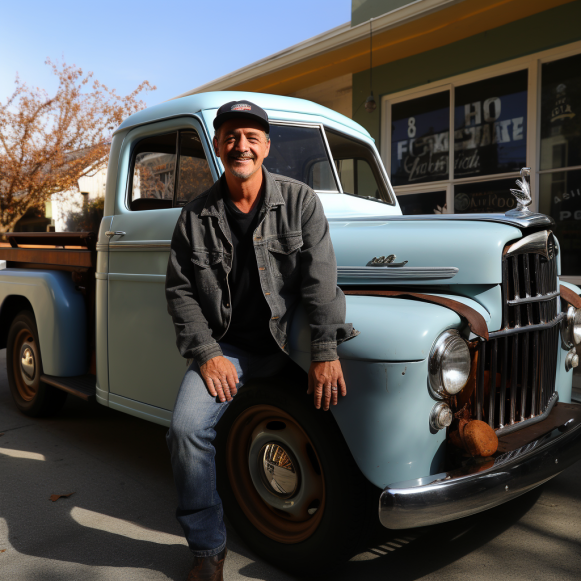Me & My Car: Brentwood owner loves his 1947 Willys Jeep pickup truck

Bought from a friend about 15 years ago and having worked on it himself, he says he’ll ‘drive it until its wheels fall off’
When the United States’ involvement in WWII became clear, the Army desired a general-purpose four-wheel drive reconnaissance vehicle.
The United States military contacted 135 companies and asked them to create a prototype vehicle in 49 days. Only two companies responded: American Bantam Car Company and Willys-Overland.
Bantam was a small company with few employees, so they contacted Karl Probst, a freelance designer from Detroit. On July 17, 1940, he began work on the project and had plans and cost estimates completed in three days.
A major consideration was to use as many off-the-shelf parts as possible and to obtain the four-wheel drivetrain from Spicer Manufacturing Co. A prototype that met or exceeded all of the US Army’s specifications was built and delivered to the Army for testing on September 23, 1940. Except for engine torque, it met all of the requirements.
Because of the volume requirements and the capacity of the Bantam, the Army decided to let Willlys and Ford modify the Bantam design. Willys won the contract, but Ford used the Willys design to become a second supplier.
During the war, the Jeep served many purposes. It transported personnel, served as an ambulance, towed guns, laid cable, fought fires, and was armed. The Jeep performed admirably on all of these and other assignments, and not just for the United States. Almost 30% of all Jeep production went to the United Kingdom and the Soviet Red Army. According to General George Marshall, the Jeep is “America’s greatest contribution to modern warfare.”
The origin of the Jeep name is unknown, but the most popular theory is that it is an acronym for “General Purpose” vehicle, with “GP” slurred to become “Jeep.” There are other theories, including one that it was named after Eugene the Jeep, a popular comic character at the time. Willys-Overland filed the first trademark applications for the Jeep name in February 1943, but other companies fought back for years. In June 1950, Willys received the registered trademark Jeep.
“It’s as faithful as a dog, as strong as a mule, and as agile as a goat,” American World War II correspondent Ernie Pyle said of the Jeep. He referred to the Jeep and the Coleman G.I. Pocket Stove as “the two most important noncombat pieces of equipment ever developed.”
Willys management chose not to manufacture their prewar car models after the war, as other automotive companies did, but instead created a civilian Jeep model, initially targeting farmers as customers. After all, no farm tractors had been built during the war, and the Jeep could do much of what a farm tractor could, and much more, better. They reasoned that a small farmer couldn’t afford a new tractor and truck but could have both with a Jeep.
They later adapted Jeep-like styling for other civilian applications. Between 1946 and 1965, the company produced 300,000 all-steel Willys Jeep wagons, which some consider to be the country’s first SUV, and 200,000 Jeep trucks, which we feature in this issue.
Mike Patton, a Brentwood resident and owner of this issue’s 1947 Willys Jeep pickup truck, is a retired corporate executive. There was no Jeep name on the truck due to legal battles at the time. Patton’s truck was a Willys-Overland pickup with the letter “W” overlaid with a “O,” the two letters forming the company’s symbol, stamped on the tailgate.
Everyone could tell it was a Jeep pickup just by looking at it, as the front styling was clearly Jeep-like. Patton has had this truck for about 15 years, having purchased it from a friend. It has a 327 cubic-inch Chevy V8 engine with an automatic transmission and power steering and brakes.
“It was pretty close to what it is now,” Patton remarked. “It belonged to a good friend of mine who lives in Grass Valley, and I had always admired it.” When I saw him, I would jokingly tell him, ‘Be careful of my truck.’
“At one point, he decided to sell it, but his asking price ($27,000) was too high.” I saw him again about a year and a half later, and he said he would sell it for a lower price ($18,000), and I said, “Sold.”
Patton was asked if he was mechanically inclined.
“Yes,” he replied, “I can do a little bit of everything with adult supervision.” I had it repainted and experimented with it. I rewired the engine, installed air conditioning, installed a more modern radio, and did some minor detail work.”
Patton is an avid collector of all things mechanical. He enjoys working on his massive 1960s Case tractor and a rusted 1960s International (Harvester) Scout off-road vehicle that I doubt has ever seen the inside of a garage. What about his parked Jeep?
“I plan to drive it until its wheels fall off,” he says.






